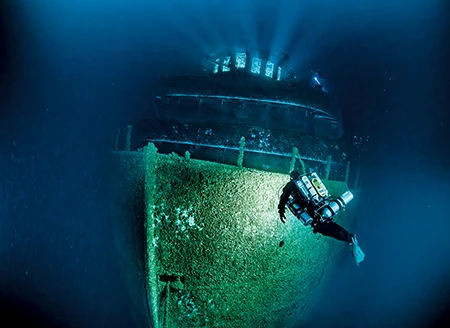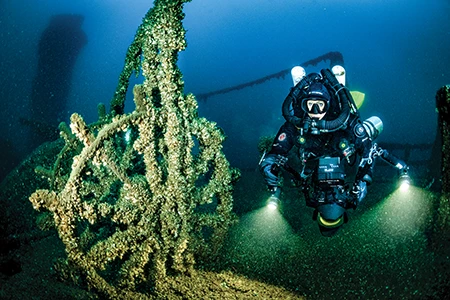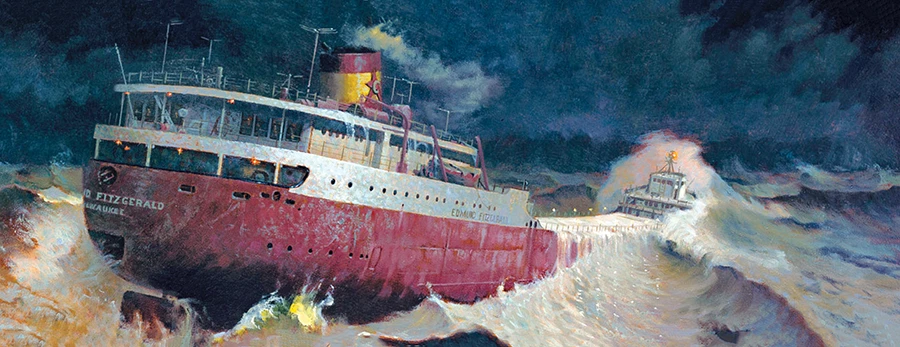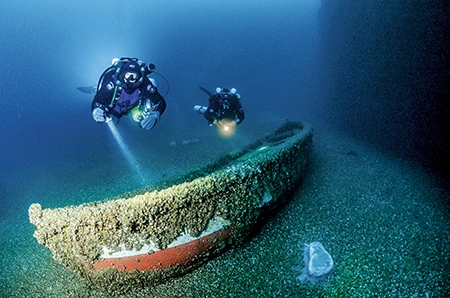The inland seas of the five Great Lakes have a long history of tragedy and shipwrecks. Mariners who sail their waters know the dangers of autumn storms. Thousands of shipwrecks litter the bottom here due to errors in judgment, equipment failure, or simply being in the wrong place at the wrong time.
The treacherous waters that plague this region have long been documented, making their way into ocean tales such as Herman Melville’s Moby-Dick, as the narrator, Ishmael, recounts to some Spanish friends: “They are swept by Borean and dismasting blasts as direful as any that lash the salted wave; they know what shipwrecks are, for out of sight of land, however inland, they have drowned full many a midnight ship with all its shrieking crew.”
The term shipwreck often conjures the idea of small, wooden sailing vessels unsuitable for stormy conditions. Perhaps surprisingly, large commercial ships foundered on the Great Lakes less than 50 years ago. The Carl D. Bradley, Daniel J. Morrell, and Edmund Fitzgerald were lost during November voyages, taking 90 men to an early grave.
How were three massive steel ships lost in similar ways? How can a lake be violent enough to cause the demise of huge commercial ships? Was there a common defect with these vessels, or was human error at fault? Why did so few of the crew survive these catastrophes? And perhaps the most important question is, Could a disaster like this happen again?
The three ships were state-of-the-art when built, and each held the title “Queen of the Lakes” as the largest ship to sail the Great Lakes at the time.
The Carl D. Bradley
The Bradley was purpose-built in 1927 to deliver limestone from Rogers City, Michigan, to different ports around the Great Lakes. As a self-unloading vessel, it could deliver a cargo of stone practically anywhere and was not dependent on shore unloading facilities. The 639-foot (195-meter) Carl D. Bradley was the flagship of the Bradley Transportation Co., with a powerful, modern propulsion system and luxury staterooms for VIPs.
On Nov. 18, 1958, the Bradley had completed its last scheduled delivery of the season on Lake Michigan and was headed to Manitowoc, Wisconsin, for winter layup and repairs. Before reaching their destination, the crew received orders to return to Rogers City to load one more delivery, as winter ice would soon stop all traffic for the season. The Bradley never saw land again.

The Great Lakes often produce hellish storms in November, and this gale was particularly fierce. Winds gusted at more than 65 mph (105 kph) with waves nearing 40-feet (12-m) high. A loud bang around 5:30 p.m. signaled the ship’s end. The stern sagged at an odd angle, and Capt. Roland Bryan gave the order to abandon ship before it broke in two. Four men reached a life raft and pulled themselves aboard. Fifteen hours later, only Elmer Fleming and Frank Mays were found clinging to life.
Ice-cold water, air temperatures below freezing, and towering waves resulted in the deaths of 33 men. The 4,000 residents of Rogers City were grief-stricken as 23 crew members called the town home. The disaster left widows on nearly every street, and 53 children lost their father that night.
The Carl D. Bradley sits upright in 375 feet (114 m) of water, broken yet defiant. I truly appreciate the ship’s scale when I see other dive team members beside the hull. Here, 23 miles (37 kilometers) offshore, resting in dim light, lies the most impressive memorial I have ever witnessed.
The pilot house sits above two intact decks that, aside from a blanket of mussels, look ready for service. Everything — portholes, anchors, railings, stairs — is as it should be. The Bradley is the largest diveable shipwreck in the Great Lakes, but few divers have been to the deck of this sleeping giant due to the combination of depth, remote location, and ice-cold water.
After the Bradley sank, researchers discovered that the brittle steel used in the construction of some ships before 1948 was prone to fracture in cold temperatures. This information was not made public and directly led to the loss of the Daniel J. Morrell.
The Daniel J. Morrell
Disaster once again struck on the last scheduled run of the season as the Daniel J. Morrell headed north into a stormy Lake Huron on Nov. 29, 1966. Winds were gusting more than 70 mph (113 kph) in the middle of the dark, howling night when the 603-foot (184-m) Morrell suddenly broke in half. The bow section began sinking rapidly as the stern half steamed into the darkness for another 5 miles (8 km) before reaching its final resting place in about 200 feet (61 m) of water.
The Morrell broke up so quickly that there was no distress call. It wasn’t until the next day, when the ship was overdue at its destination, that people realized the full scope of the tragedy. Only one man from the crew of 29 survived. For 38 hours Dennis Hale floated on a raft in the bitterly cold storm before the U.S. Coast Guard found him. He had somehow survived the freezing conditions wearing very little clothing.

A dive to the Morrell’s deck is a powerful experience. The engine room contains equipment and tools in their final resting place, and the telegraph, switches, and spare parts are frozen in time. This place feels like a sacred cathedral, and the silence of our rebreathers seems appropriate here. We feel the importance of not disturbing a single piece of this shrine and moving with care and respect. The large auxiliary double wheel remains intact on the stern deck and seems oddly out of place on such a large ship.
The Morrell’s sister ship, Edward Y. Townsend, was damaged in the same storm and developed several large cracks on its deck. The Townsend was being towed across the Atlantic Ocean to the scrapyard in 1968 when it also split in two and sank near the location of the Titanic.
A final report on the disaster showed that brittle steel was responsible for the loss of the Morrell and the deaths of 28 men. The industry was confident that with improved technologies a tragedy like this could never happen again, even on the larger ships being built at the time.

The Edmund Fitzgerald
The 729-foot (222-m) ore carrier affectionately known as Big Fitz launched in 1958, the same year the Carl D. Bradley sank. Seventeen years later, on Nov. 9, 1975, the Edmund Fitzgerald was crossing the world’s largest expanse of fresh water with a crew of 29. An approaching fall gale was predicted to be well south of the ship’s route on Lake Superior, but later that evening a revised forecast indicated a 60-mph (97 kph) storm with blinding snow centered directly over the Fitzgerald’s path.
The freighter Arthur M. Anderson was following the Fitzgerald that night, and its captain, Bernie Cooper, was in radio contact with Capt. Ernest M. McSorley of the Fitzgerald. On the afternoon of Nov. 10, the Fitzgerald was taking damage from immense waves crashing over its deck. Winds were gusting more than 80 mph (129 kph), and both freighters were fighting for survival.
The Swedish ship Avafors radioed to McSorley that the Whitefish Point lighthouse had lost power, and he responded, “I have a bad list, lost both radars, and am taking heavy seas over the deck. One of the worst seas I have ever been in.” The Anderson closed to within 10 miles (16 km) to guide the Fitzgerald as they both steamed southeast toward Whitefish Bay.
By 7:20 p.m., the Anderson could no longer contact the Fitzgerald by radio or locate it on radar. No distress call was ever received. The massive Edmund Fitzgerald had simply vanished.
The wreckage of the Fitzgerald was later located in two large sections in more than 530 feet (162 m) of water. It was clear it had split in two before reaching the bottom. With no survivors or witnesses, we may never know the exact cause of the ship’s demise. The tremendous seas encountered that night caused a violent and rapid structural failure that took the Fitzgerald and its entire crew of 29 to the bottom.
The shipwreck lies inside Canadian waters and is now a restricted site under the Ontario Heritage Act of 2005. Diving operations are not permitted there.
Great Lakes Freighters Today
The SS Alpena currently is the oldest commercial freighter operating on the Great Lakes. It has plied the Great Lakes for 82 years and has seen many of its contemporaries sent to the scrapyard. Clearly, these ships can continue to sail for decades, provided they are properly maintained and operated within their abilities.
The Arthur M. Anderson was launched in 1957 and remains a common sight on the Great Lakes, continuing to deliver cargo of stone and ore wherever needed. November still delivers powerful storms, and mariners heed the warnings from previous disasters, knowing well the risks associated with the last run of the season.
How To Dive It
Conditions: The best time of year to dive the Great Lakes is June through September. Water temperatures average 39°F (3.9°C) at depth, so a drysuit with proper insulation is required. Visibility is often excellent at these sites, sometimes exceeding 100 feet (30 m).
Dive support: Several operators run charters to the Daniel J. Morrell throughout the summer with advance reservations. It is an advanced dive site, and you will have to show proof of certification. No active charters run to the Carl D. Bradley. You will need a skilled captain, dive team, and support crew to locate and safely dive this remote shipwreck.

Explore More
Learn more about the sinking of the Carl D. Bradley and the Edmund Fitzgerald in these videos.
© Alert Diver – Q3 2024